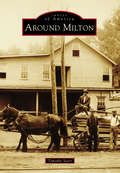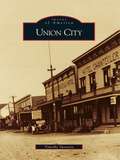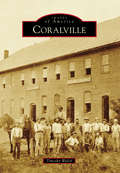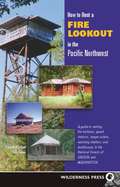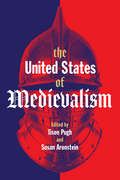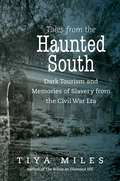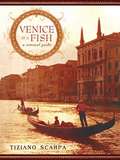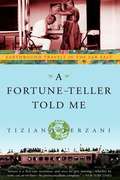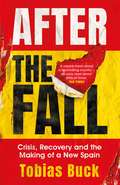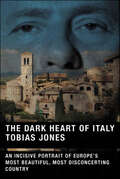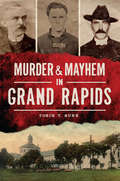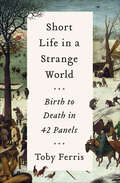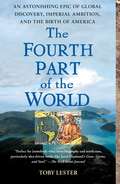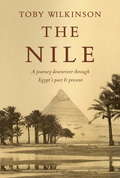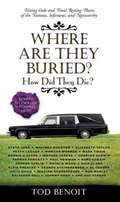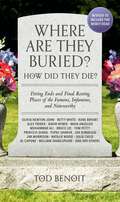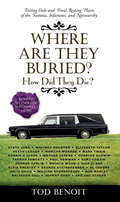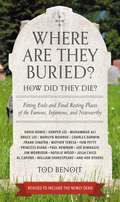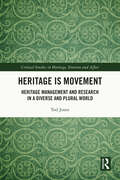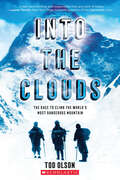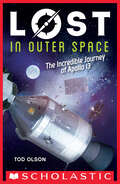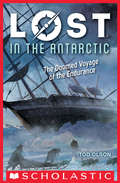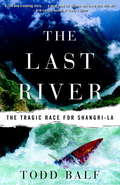- Table View
- List View
Around Milton
by Timothy StarrThe town of Milton, New York, lies near the center of Saratoga County. It is crisscrossed by a series of rivers, which have played an important role in the town's development--most notably, the Kayaderosseras. Milton's only village, Ballston Spa, with the attraction of its rare mineral springs, was once among the country's most popular tourist destinations. One of the largest and most elegant hotels in the world, the Sans Souci, vied with a host of others for the patronage of thousands of travelers who made the pilgrimage each summer to partake in the "healing waters." When the tourist trade faded, it was replaced by a massive expansion of industry that was situated along the town's waterways. Among the most significant of these concerns were the mills of the "Paper Bag King" George West, Isaiah Blood's ax and scythe works, and the mammoth tannery of Samuel Haight. Today, its proximity to the state capital and other cities makes the town an increasingly popular residential area, complemented by a quaint and bustling business district in Ballston Spa.
Union City
by Timothy SwensonUnion City was formed by the merging of two communities, Alvarado and Decoto. In the early 1850s, Alvarado was founded as a place to ship local produce to San Francisco. When Alameda County was created in 1853, Alvarado became the county seat and the hub of business activity for the county. The proximity of Alameda Creek to Alvarado, with its yearly floods, would cause the county seat to move to San Leandro and then Oakland. In the 1870s, Decoto was founded as a rail town on the new transcontinental railroad. Agriculture formed the start of Decoto, and eventually canneries cropped up along the railroad tracks, making local produce available around the country. In 1938, Pacific States Steel created jobs that expanded the town, making it the largest employer in Decoto for many years. In 1959, the towns of Alvarado and Decoto joined to form Union City. The first mayor of Union City, Tom Kitayama, was the first Japanese American mayor in the United States.
Coralville
by Timothy WalchAlthough Coralville is a lot like other small American cities, it is unique as the only community of that name in the United States. Located on the Iowa River, the name refers to the ancient coral reefs that are its geological bedrock. The river has always been a key aspect of Coralville's history, along with its proximity to Iowa City, the first capital of the Territory of Iowa and the home of the University of Iowa. Incorporated as a city in 1873, Coralville had few residents until the 1960s, when dynamic commercial and residential development brought substantial growth to the area. Today, Coralville is a city of industry, commerce, and hospitality. It is not surprising, therefore, that "Coralville Pride" is the city motto.
How to Rent a Fire Lookout in the Pacific Northwest
by Tom Foley Tish McfaddenThis completely updated edition of the first complete guide to the cabins and fire lookouts available for rent in Oregon and Washington now covers a total of 61 properties (29 new!). Ranging from a luxurious cabin just off the road to a remote 60-foot tower deep in the wilderness, these scenic, secluded, and historic structures can be your own private place in the woods.
The United States of Medievalism
by Tison Pugh and Susan AronsteinThe United States of Medievalism contemplates the desires, dreams, and contradictions inherent in experiencing the Middle Ages in a nation that is so temporally, spatially, and at times politically removed from them. The European Middle Ages have long influenced the national landscape of the United States through the medieval sites that permeate its self-announced republican landscapes and cities. Today, American-built medievalisms continue to shape the nation’s communities, collapsing the binaries between past and present, medieval and modern, European and American. The volume’s chapters visit the nation’s many medieval-inspired spaces, from Sherwood Forest in Texas to California’s San Andreas Fault. Stops are made in New York City’s churches, Boston’s gardens, Philadelphia’s Bryn Athyn Cathedral, Orlando’s Magic Kingdom, Appalachian highways, Minnesota’s Viking Villages, New Orleans’s Mardi Gras, and the Las Vegas Strip. As the editors and their fellow essayists take the reader on this cross-country trip across the United States, they ponder the cultural work done by the nation’s medievalized spaces. In its exploration of a seemingly distant period, this collection challenges the underexamined legacy of medievalism on the western side of the Atlantic. Full of intriguing case studies and reflections, this book is informative reading for anyone interested in the contemporary vestiges of the Middle Ages.
Tales from the Haunted South: Dark Tourism and Memories of Slavery from the Civil War Era (The Steven and Janice Brose Lectures in the Civil War Era)
by Tiya MilesIn this book Tiya Miles explores the popular yet troubling phenomenon of "ghost tours," frequently promoted and experienced at plantations, urban manor homes, and cemeteries throughout the South. As a staple of the tours, guides entertain paying customers by routinely relying on stories of enslaved black specters. But who are these ghosts? Examining popular sites and stories from these tours, Miles shows that haunted tales routinely appropriate and skew African American history to produce representations of slavery for commercial gain. "Dark tourism" often highlights the most sensationalist and macabre aspects of slavery, from salacious sexual ties between white masters and black women slaves to the physical abuse and torture of black bodies to the supposedly exotic nature of African spiritual practices. Because the realities of slavery are largely absent from these tours, Miles reveals how they continue to feed problematic "Old South" narratives and erase the hard truths of the Civil War era. In an incisive and engaging work, Miles uses these troubling cases to shine light on how we feel about the Civil War and race, and how the ghosts of the past are still with us.
Venice Is a Fish
by Tiziano ScarpaOne of Italy's brightest literary lights reinvents travel writing with a seductive, intoxicating celebration of the magical saltwater city "Venice is a fish," writes Tiziano Scarpa. "It's like a vast sole stretched out against the deep. How did this marvelous beast make its way up the Adriatic and fetch up here, of all places?" Paying homage to his native city in a lyrical and evocative style, he guides readers down tiny alleys, over bridges, and through squares, daring us to lose ourselves, forget the guidebooks, and experience Venice as Venetians do. Venice Is a Fish provides no hotel ratings or museum hours. Instead, in a delightful initiation, Scarpa tells us how to balance while standing on a gondola; where lovers will find the best secret hiding places; the finer points of etiquette and navigation during an agua alta; and how best to defend ourselves from the pitiless beauty of one of the world's most stimulating cities. Open Venice Is a Fish, and Scarpa's magnificent images, secret history, and hidden lore unfold like a treasure map of the senses.
A Fortune-Teller Told Me: Earthbound Travels in the Far East
by Tiziano TerzaniNow in paperback, this work by Terzani, a jet-age Asian correspondent, recounts his year of traveling the Far East by foot, boat, bus, car, and train--but never by airplane--while rediscovering the land, the people, and himself.
After the Fall: Crisis, Recovery and the Making of a New Spain
by Tobias BuckTobias Buck arrived in Madrid in December 2012, in time to celebrate the bleakest Christmas the city had seen in a generation. Capital and country were reeling from a series of economic shocks that had brought Spain to the brink of ruin. The housing boom had dramatically turned to bust, a large chunk of the nation's banking system was in state hands, businesses were closing across the country, debt was spiralling out of control and unemployment levels had reached a record high.AFTER THE FALL presents a rich and vivid portrait of contemporary Spain at a critical moment in the country's history. The book tells the story of Spain's long boom and sudden bust, the brutal economic crisis that followed, and the political and social aftershocks that reverberate to this day. It explores the origins of the separatist movement in Catalonia, and its bitter clash with the Spanish government that culminated in a failed secession referendum and a divisive declaration of independence. It looks at the legacy of the Civil War and Franco dictatorship, and the continuing struggle over historical memory in Spain today. Based on five years of reporting and hundreds of interviews, AFTER THE FALL takes the reader from the offices of power in Madrid and Barcelona to the villages of the Basque country, still haunted by the memory of political violence, and to the towns of Andalusia, where an entire generation has seen its economic hopes shattered. It describes how the country has been changed by the experience of migration, and why - after decades at the margins - the far-right eventually made a return to Spanish politics. For all the problems and challenges facing Spain today, we see that amid the ruins of the crisis, the search for a new Spanish model is already underway.
After the Fall: Crisis, Recovery and the Making of a New Spain
by Tobias BuckTobias Buck arrived in Madrid in December 2012, in time to celebrate the bleakest Christmas the city had seen in a generation. Capital and country were reeling from a series of economic shocks that had brought Spain to the brink of ruin. The housing boom had dramatically turned to bust, a large chunk of the nation's banking system was in state hands, businesses were closing across the country, debt was spiralling out of control and unemployment levels had reached a record high.AFTER THE FALL presents a rich and vivid portrait of contemporary Spain at a critical moment in the country's history. The book tells the story of Spain's long boom and sudden bust, the brutal economic crisis that followed, and the political and social aftershocks that reverberate to this day. It explores the origins of the separatist movement in Catalonia, and its bitter clash with the Spanish government that culminated in a failed secession referendum and a divisive declaration of independence. It looks at the legacy of the Civil War and Franco dictatorship, and the continuing struggle over historical memory in Spain today. Based on five years of reporting and hundreds of interviews, AFTER THE FALL takes the reader from the offices of power in Madrid and Barcelona to the villages of the Basque country, still haunted by the memory of political violence, and to the towns of Andalusia, where an entire generation has seen its economic hopes shattered. It describes how the country has been changed by the experience of migration, and why - after decades at the margins - the far-right eventually made a return to Spanish politics. For all the problems and challenges facing Spain today, we see that amid the ruins of the crisis, the search for a new Spanish model is already underway.
The Dark Heart of Italy: An Incisive Portrait of Europe's Most Beautiful, Most Disconcerting Country
by Tobias JonesIn 1999 Tobias Jones immigrated to Italy, expecting to discover the pastoral bliss described by centuries of foreign visitors. Instead, he found a very different country: one besieged by unfathomable terrorism and deep-seated paranoia. The Dark Heart of Italy is Jones's account of his four-year voyage across the Italian peninsula.Jones writes not just about Italy's art, climate, and cuisine but also about the much livelier and stranger sides of the Bel Paese: the language, soccer, Catholicism, cinema, television, and terrorism. Why, he wonders, does the parliament need a "slaughter commission"? Why do bombs still explode every time politics start getting serious? Why does everyone urge him to go home as soon as possible, saying that Italy is a "brothel"? Most of all, why does one man, Silvio Berlusconi--in the words of a famous song--appear to own everything from Padre Nostro (Our Father) to Cosa Nostra (the Mafia)?The Italy that emerges from Jones's travels is a country scarred by civil wars and "illustrious corpses"; a country that is proudly visual rather than verbal, based on aesthetics rather than ethics; a country where crime is hardly ever followed by punishment; a place of incredible illusionism, where it is impossible to distinguish fantasy from reality and fact from fiction.
Murder & Mayhem in Grand Rapids (Murder & Mayhem)
by Tobin T. BuhkWhile the River City is known for its history of furniture making, it also has a sinister side. Jennie Flood was a widow with a get-rich scheme that involved a shotgun and an insurance application. Reverend Ferris went undercover in his war against the city's purveyors of vice. The police rounded up the usual suspects in an attempt to solve the infamous 1921 bank heist that led to the slaying of two detectives. And the death of a teenager exposed "Aunty" Smith and her dangerous side business conducted in the shadows. Author Tobin T. Buhk delves into the colorful characters of Grand Rapids' past and the heinous crimes they committed.
Short Life in a Strange World: Birth to Death in 42 Panels
by Toby FerrisAn exceptional work that is at once an astonishing journey across countries and continents, an immersive examination of a great artist&’s work, and a moving and intimate memoir—now available in paperback. In 2012, facing the death of his father and impending fatherhood, Toby Ferris set off on a seemingly quixotic mission to track down and look at—in situ—every painting still in existence by Pieter Bruegel the Elder, the most influential and important artist of Northern Renaissance painting. The result of that pursuit is a remarkable journey through major European cities and across continents. As Ferris takes a keen analytical eye to the paintings, each piece brings new revelations about Bruegel&’s art, and gives way to meditations on mortality, fatherhood, and life. Ferris conjures a whole world to which most of us have probably lost the key, and in the process teaches us how to look, patiently and curiously, at the world. Short Life in a Strange World is a dazzlingly original and assured debut—a strange and bewitching hybrid of art criticism, philosophical reflection, and poignant memoir. Beautifully illustrated with sixty-six color images, it subtly alters the way we see the world and ourselves.
The Fourth Part of the World: The Race to the Ends of the Earth, and the Epic Story of the Map That Gave America Its Name
by Toby Lester“Old maps lead you to strange and unexpected places, and none does so more ineluctably than the subject of this book: the giant, beguiling Waldseemüller world map of 1507.” So begins this remarkable story of the map that gave America its name.For millennia Europeans believed that the world consisted of three parts: Europe, Africa, and Asia. They drew the three continents in countless shapes and sizes on their maps, but occasionally they hinted at the existence of a "fourth part of the world," a mysterious, inaccessible place, separated from the rest by a vast expanse of ocean. It was a land of myth—until 1507, that is, when Martin Waldseemüller and Matthias Ringmann, two obscure scholars working in the mountains of eastern France, made it real. Columbus had died the year before convinced that he had sailed to Asia, but Waldseemüller and Ringmann, after reading about the Atlantic discoveries of Columbus’s contemporary Amerigo Vespucci, came to a startling conclusion: Vespucci had reached the fourth part of the world. To celebrate his achievement, Waldseemüller and Ringmann printed a huge map, for the first time showing the New World surrounded by water and distinct from Asia, and in Vespucci’s honor they gave this New World a name: America. The Fourth Part of the World is the story behind that map, a thrilling saga of geographical and intellectual exploration, full of outsize thinkers and voyages. Taking a kaleidoscopic approach, Toby Lester traces the origins of our modern worldview. His narrative sweeps across continents and centuries, zeroing in on different portions of the map to reveal strands of ancient legend, Biblical prophecy, classical learning, medieval exploration, imperial ambitions, and more. In Lester’s telling the map comes alive: Marco Polo and the early Christian missionaries trek across Central Asia and China; Europe’s early humanists travel to monastic libraries to recover ancient texts; Portuguese merchants round up the first West African slaves; Christopher Columbus and Amerigo Vespucci make their epic voyages of discovery; and finally, vitally, Nicholas Copernicus makes an appearance, deducing from the new geography shown on the Waldseemüller map that the earth could not lie at the center of the cosmos. The map literally altered humanity’s worldview. One thousand copies of the map were printed, yet only one remains. Discovered accidentally in 1901 in the library of a German castle it was bought in 2003 for the unprecedented sum of $10 million by the Library of Congress, where it is now on permanent public display. Lavishly illustrated with rare maps and diagrams, The Fourth Part of the World is the story of that map: the dazzling story of the geographical and intellectual journeys that have helped us decipher our world.
The Nile: A Journey Downriver Through Egypt's Past and Present (Vintage Departures)
by Toby WilkinsonA hypnotic journey in the company of one of the world's most acclaimed Egyptologists over the fabled river telling how the Nile continually brought life to an ancient civilization now dead and how it sustained its successors, now in tumult.Renowned Egyptologist Toby Wilkinson leads us through space as much as time: from the river's mystical sources (the Blue Nile which rises in Ethiopia, and the White Nile coursing from majestic Lake Victoria); to Thebes, with its Valley of the Kings, Valley of the Queens, and Luxor Temple; the fertile Delta; Giza, home of the Great Pyramid, the sole surviving Wonder of the Ancient World; and finally, to the pulsating capital city of Cairo, where the Arab Spring erupted on the bridges over the Nile. Along the way, he introduces us to mysterious and fabled characters-the gods, godlike pharaohs, emperors and empresses, who joined their fate to the Nile and gained immortality; the adventurers, archaeologists, and historians who have all fallen under its spell. With matchless erudition and storytelling skill, through a lens equal to both panoramas and close-ups, Wilkinson brings millennia of history into view.
Where Are They Buried?
by Tod BenoitThe perennially best-selling guide to the lives, deaths, and final resting places of our most enduring cultural icons, now revised and completely updated to include 25 entries of the newly dead. Where Are They Buried? has directed legions of fervent fans and multitudes of the morbidly curious to the gravesides, monuments, memorials, and tombstones of the nearly 500 celebrities and antiheros included in the book. By far the most complete and well-organized guide on the subject, every entry features an entertaining capsule biography full of little-known facts; a detailed description of the death; and step-by-step directions to the site of the grave, including not only the name of the cemetery but the specific roads and trails to take within the cemetery to reach the gravesite. The book also provides a handy index of grave locations organized by state, province, and country to make planning a grave-hopping road trip easy and efficient.New entries include Steve Jobs, Whitney Houston, Neil Armstrong, Elizabeth Taylor, Dick Clark and twenty more.
Where Are They Buried? (2023 Revised and Updated): How Did They Die? Fitting Ends and Final Resting Places of the Famous, Infamous, and Noteworthy
by Tod BenoitThis bestselling guide to the lives, deaths, and final resting places of our most enduring cultural icons has been revised and updated to include celebrities like Betty White, Alex Trebek, and many more.Where Are They Buried? has directed legions of fervent fans and multitudes of the morbidly curious to the graves, monuments, and tombstones of the more than 500 celebrities and antiheroes included in the book. The most comprehensive guide on the subject by far, every entry features an entertaining capsule biography full of little-known facts, a detailed description of the death, and step-by-step directions to the grave, including not only the name of the cemetery but the exact location of the gravesite and how to reach it. The book also provides a handy index of grave locations organized by state, province, and country to make planning a grave-hopping road trip easy and efficient. The 2023 edition adds 8 new entries including Kobe Bryant, Eddie Van Halen, and Regis Philbin.
Where Are They Buried?: How Did They Die? Fitting Ends and Final Resting Places of the Famous, Infamous, and Noteworthy (Revised & Updated)
by Tod BenoitThe perennially best-selling guide to the lives, deaths, and final resting places of our most enduring cultural icons, now revised to include 25 additional entries. Where Are They Buried? has directed legions of fervent fans and multitudes of the morbidly curious to the gravesides, monuments, memorials, and tombstones of the nearly 500 celebrities and antiheros included in the book. By far the most complete and well-organized guide on the subject, every entry features an entertaining capsule biography full of little-known facts; a detailed description of the death; and step-by-step directions to the site of the grave, including not only the name of the cemetery but the specific roads and trails to take within the cemetery to reach the gravesite. The book also provides a handy index of grave locations organized by state, province, and country to make planning a grave-hopping road trip easy and efficient.Additional entries include Steve Jobs, Whitney Houston, Neil Armstrong, Elizabeth Taylor, Dick Clark and twenty more.
Where Are They Buried?: How Did They Die? Fitting Ends and Final Resting Places of the Famous, Infamous, and Noteworthy
by Tod BenoitThe bestselling guide to the lives, deaths, and final resting places of our most enduring cultural icons, now revised and completely updated for 2019. Where Are They Buried? has directed legions of fervent fans and multitudes of the morbidly curious to the graves, monuments, memorials, and tombstones of the nearly 500 celebrities and antiheroes included in the book. The most complete and well-organized guide on the subject by far, every entry features an entertaining capsule biography full of little-known facts, a detailed description of the death, and step-by-step directions to the grave, including not only the name of the cemetery but the exact location of the gravesite and how to reach it. The book also provides a handy index of grave locations organized by state, province, and country to make planning a grave-hopping road trip easy and efficient.
Heritage is Movement: Heritage Management and Research in a Diverse and Plural World (Critical Studies in Heritage, Emotion and Affect)
by Tod JonesThis book presents new ways of understanding heritage and heritage work. It addresses the ways physical processes of creation, maintenance and decay are entangled with cultural and political processes of management, access and care. The book analyzes a critical practice of heritage work oriented to recognizing and collaborating with diverse knowledge holders and their practices of caring for heritage. This requires rethinking accepted heritage concepts, such as heritage management, artifact, site and the definition of heritage itself. The book presents an engaging and applied approach to this task through examples that include Majapahit statues and temples in Indonesia, skating in London, an online heritage movement, building bivouacs in Australia, First Nations advocacy for Country and batik collections in the Netherlands. Offering a new model for collaborative heritage research and analysis, this book will be of interest to researchers, students and practitioners. Drawing from developments from the posthumanities, cultural geography and critical heritage studies, it presents a collaborative mode of scholarship and writing that considers how people care for and use the things history leaves them.
Into the Clouds (Scholastic Focus): The Race To Climb The World's Most Dangerous Mountain
by Tod OlsonA nail-biting tale of survival and brotherhood atop one of the world's most dangerous mountains.This fast-paced, three-part narrative takes readers on three expeditions over 15 years to K2, one of the deadliest mountains on Earth. Roped together, these teams of men face perilously high altitudes and battering storms in hopes of reaching the summit. As each expedition sets out, they carve new paths along icy slopes and unforgiving rock, creating camps on ledges so narrow they fear turning over in their sleep.But disaster strikes -- in 1939, four men never make it down the mountain. Fourteen years later, a man develops blood clots in his legs at 25,000 feet, leaving his team with no safe path off the mountain. Filled with displays of incredible strength and heart-stopping danger, Into the Clouds tells the incredible stories of the men whose quest to conquer a mountain became a battle to survive the descent.
Lost in Outer Space: The Incredible Journey of Apollo 13 (Lost #2)
by Tod OlsonFor middle grade space enthusiasts, the amazing true story of the doomed Apollo 13 moon mission that nearly ended in disaster.April 13, 1970: Two hundred thousand miles from Earth and counting, an explosion rips through Jim Lovell’s spacecraft. The crippled ship hurtles toward the moon at three times the speed of sound, losing power and leaking oxygen into space. Lovell and his crew were two days from the dream of a lifetime—walking on the surface of moon. Now, they will count themselves lucky to set foot on Earth again. From “Houston, we’ve had a problem” to the final tense moments at Mission Control, Lost in Outer Space takes readers on the unbelievable journey of Apollo 13 and inside the minds of its famous and heroic astronauts. Complete with photographs of the crew and diagrams of the spacecraft, this is an up-close-and-personal look at one of the most thrilling survival stories of all time.“Fans of action-packed true survival stories will take to this real-life space episode—an easy pick for upper elementary schoolers.” —School Library Journal
Lost in the Antarctic: The Doomed Voyage of the Endurance (Lost #4)
by Tod OlsonClimb aboard the doomed ship Endurance to join famed explorer Ernest Shackleton and his crew who must battle the frigid Antarctic elements to survive being stranded at the edge of the world.There wasn't a thing Ernest Shackleton could do. He stood on the ice-bound Weddell Sea, watching the giant blocks of frozen saltwater squeeze his ship to death. The ship's name seemed ironic now: the Endurance. But she had lasted nine months in this condition, stuck on the ice in the frigid Antarctic winter. So had Shackleton and his crew of 28 men, trying to become the first expedition ever to cross the entire continent.Now, in October 1915, as he watched his ship break into pieces, Shackleton gave up on that goal. He ordered his men to abandon ship. From here on, their new goal would be to focus on only one thing: survival.Filled with incredible photographs that survived the doomed voyage of the Endurance, Lost in the Antarctic retells one of the greatest adventure and exploration stories of all time.
The Last River
by Todd BalfIt was the ultimate whitewater adventure on the Mount Everest of rivers, and the biggest challenge of their lives....October 1998 an American whitewater paddling team traveled deep into the Tsangpo Gorge in Tibet to run the Yarlung Tsangpo, known in paddling circles as the "Everest of rivers." On Day 12 of that trip, the team's ace paddler, one of four kayakers on the river, launched off an eight-foot waterfall and flipped. He and his overturned kayak spilled into the heart of the thunderous "freight training" river and were swept downstream, never to be seen again.The Last River: The Tragic Race for Shangri-la is a breathtaking account of this ill-fated expedition, a fascinating exploration of what propelled these kayakers to take on the seething big water and perilous Himalayan terrain of the deepest gorge on the planet. This was the magical Shangri-la of legend, a 140-mile-long canyon framed by 25,000-foot snowcapped peaks, a place of unimaginable beauty called Pemako in ancient Buddhist texts that was rumored to contain mammoth waterfalls. At the close of the twentieth century, an end-to-end descent of the gorge filled the imaginations of some of the best boaters in the world, who saw in the foam and fury of the Tsangpo's rapids the ultimate whitewater challenge. For Wick Walker and Tom McEwan, extreme whitewater pioneers, best friends, and trip leaders, the Tsangpo adventure with Doug Gordon, Olympic medal-winning paddler Jamie McEwan (Tom's brother), and Roger Zbel was the culmination of a twenty-five-year quest. Fueled by narratives of early explorers, Walker and McEwan kept their dream alive and waited until the Chinese government opened the gorge to Westerners. With financial backing from the National Geographic Society, the group was finally good to go in 1998. Swollen to three times the size they had expected because of record rains and heavy snowmelt, the Tsangpo lived up to its fearsome reputation. On numerous occasions the team questioned whether to continue, but chose to press forward. The Last River probes beyond the extreme sports clichés and looks at the complex personal and intellectual reasons for the seemingly irresistible draw of Tibet's Great River. For Walker, Gordon, Zbel, and the McEwans -- husbands, fathers, friends, and brothers -- the Tsangpo wasn't a run toward death but a celebration of life, adventure, and the thing that tied them to one another -- awe-inspiring rivers. The Last River is also a riveting journey to one of the world's wildest and most alluring places, a thrilling book that invites us into the Himalayas of Jon Krakauer's classic, Into Thin Air, but from a totally new perspective -- on a historic river so remote that only the most hardy and romantic souls attempt to unlock its mysteries. Visit www.randomhouse.com/features/lastriverFrom the Hardcover edition.
